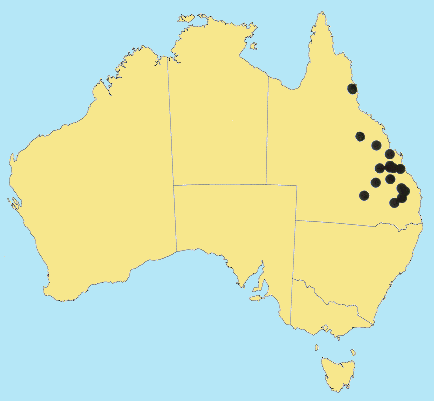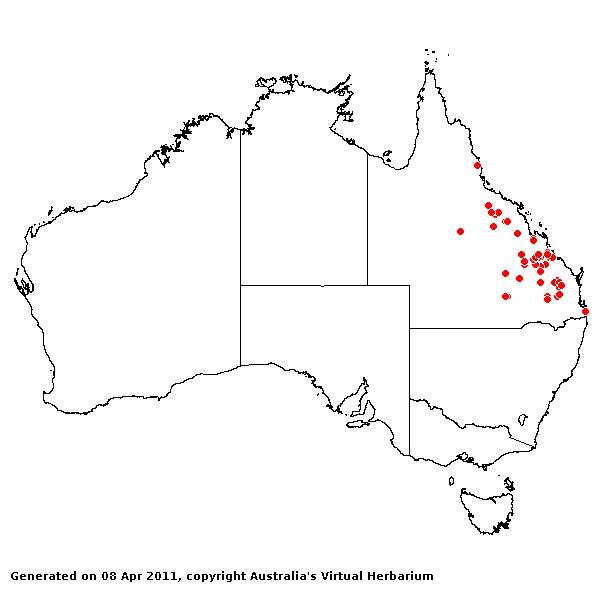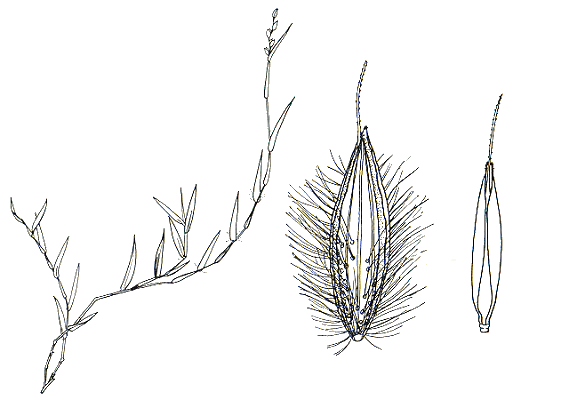Calyptochloa gracillima C. E. Hubbard. Hooker's Icon. Pl. 33: t. 3210, 1–3 (1933).
Classification. (GPWG 2001) : Subfamily Panicoideae. Paniceae.
Type of Basionym or Protologue Information: HT: H.S. Bloxsome s.n., 1931, Australia: Queensland (K; IT: US-1539929 (fragm. ex K)).
Key references (books and floras): [2002] D.Sharp & B.K.Simon, AusGrass, Grasses of Australia.
Illustrations: [1983] J.C.Tothill & J.B.Hacker, Grasses of Southern Queensland (144).
Habit. Perennial. Stolons present. Culms decumbent, 10–30 cm tall, wiry. Mid-culm internodes pilose. Mid-culm nodes pubescent. Lateral branches sparsely branched. Leaves cauline. Leaf-sheaths hairy. Ligule a fringe of hairs, 0.25–0.4 mm long. Leaf-blades linear to lanceolate, 1.2–4 cm long, 2–6 mm wide. Leaf-blade surface indumented.
Inflorescence. Inflorescence solid, a raceme (spike-like). Racemes 1, 1–1.5 cm long, bearing 5–7 fertile spikelets on each.
Spikelets. Spikelets pedicelled. Fertile spikelets 2-flowered, the lower floret barren (rarely male), the upper fertile, comprising 1 basal sterile florets, comprising 1 fertile floret(s), without rachilla extension, ovate, dorsally compressed, 3–5.1 mm long.
Glumes. Glumes thinner than fertile lemma. Lower glume surface glabrous or indumented. Upper glume ovate, 3.4–4.7 mm long, herbaceous, without keels, 7 -nerved. Upper glume surface tuberculate, indumented. Florets. Basal sterile florets 1, barren, without significant palea. Lemma of lower sterile floret 100 % of length of spikelet, herbaceous, 5–9 -nerved.
Fertile lemma 2.4–4 mm long, without keel, 5 -nerved. Lemma surface glabrous. Lemma apex awned, 1 -awned. Median (principal) awn 1.5–3 mm long overall. Palea 2 -nerved, without keels. Lodicules present. Grain 1.6–1.8 mm long.
Continental Distribution: Australasia.
Australian Distribution: Queensland.
Queensland: Burnett, Cook, Darling Downs, Leichhardt, Maranoa, North Kennedy, Port Curtis, South Kennedy.
Notes. This species has been poorly collected and intensive fieldwork is needed to fully reveal the range in morphological variation. The cleistogamous spikelets are sessile and occur singly or in pairs in the upper axils. These spikelets are c. 5.5 mm long and differ in shape and lack the setae of the chasmogamous spikelet. A well-formed caryopsis is always present.
In Brigalow forests, tropical and subtropical sub-humid woodlands, and semi-arid shrub woodlands. Flowers Jan.-Aug.




